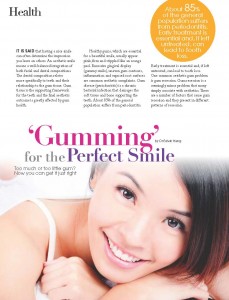 This article first appeared in the August 2014 issue of Ezyhealth magazine. We have reproduced it for the information of those of you who missed it when it was published.
This article first appeared in the August 2014 issue of Ezyhealth magazine. We have reproduced it for the information of those of you who missed it when it was published.
It is said that having a nice smile can often determine the impression you leave on others. An aesthetic smile means having a well-balanced integration of both facial and dental compositions. The dental composition relates more specifically to teeth and their relationship to the gum tissues. Gum tissue is the supporting framework for the teeth and the final aesthetic outcome is greatly affected by gum health.
Healthy gums, which are essential for a beautiful smile, usually appear pink, firm and stippled like an orange peel. Excessive gingival display (gummy smile), uneven gum contours, inflammation and exposed root surfaces are common aesthetic complaints. Gum disease (Periodontitis) is a chronic bacterial infection that damages the soft tissue and bone supporting the teeth. About 85% of the general population suffers from periodontitis. Early treatment is essential and, if left untreated, can lead to tooth loss.
One common aesthetic gum problem is gum recession. Gum recession is a seemingly minor problem that many simply associate with aesthetics. There are a number of factors that cause gum recession and they present in different patterns of recession.
Types of Gum Problems
- Localised gum recession
This is usually caused by severe toothbrush abrasion and trauma. This is often self-limiting, but occasionally can be progressive and compromise the tooth. When patients have gingival recession with bleeding pockets it could be an open source of infection. Patients can have a healthy mouth and practice good oral hygiene and yet, still experience site-specific areas of gingival recession. Most are not even aware of it or for those who aware, it is often regarded as an unavoidable part of the ageing process.
Gum recession can lead to the exposure of the tooth’s root surface, causing esthetic problems and tooth sensitivity. Treatment of gum recession is indicated when there is a risk of such progression, or when the recession has led to an esthetic concern. This is particularly true in patients who have a high smile line, showing the gums when they smile. Early diagnosis and treatment of gingival recession is important because the situation can worsen to where predictable root coverage is not possible and esthetics becomes compromised.
Treatment
Coverage of gum recession involves a minor surgical procedure that moves the adjacent gum over the recession. A small piece of tissue from the palate is often harvested and added to the missing gum over the recession. If the patient does not have sufficient “donor” tissue from the palate, the gum specialist (periodontist) has the option of using pre-packaged sterilized allodermic tissue from human/animal origins, to add to the missing gum.
- Gummy smile
At the other extreme end of esthetic gum problems, we also see patients who exhibit “too much” gums, that is, having a “gummy” smile.
Treatment
Aesthetic crown lengthening can be a treatment option for such patients. Simply put, it is the cutting away of the extra gums to expose the tooth underneath. To obtain a predictable and stable long term result, some degree of the underlying bone level may be required. To achieve this, the gums must be raised, the underlying bone adjusted to re-establish the proper anatomical relationship, and the gums adjusted down to the desired level.
The “ideal” smile should not show more than three millimeters of gums between the top of your tooth and the bottom of your upper lip. A beautiful smile depends on a number of factors, among which are the displays and architecture of gum tissue as well as its contour and position.
The appearance of the gingival contour follows the underlying bone architecture and is influenced primarily by factors such as tooth position, biotype of gum tissue and tooth form. Hence, there is an increasing importance of the combined inter-disciplinary works of orthodontics (teeth alignment) and periodontics specialties to influence the overall aesthetic impact.
Dr Edwin Heng is a Dental Specialist in Periodontics at Specialist Dental Group®, Gleneagles. He was awarded the Singapore Armed Forces (SAF) Postgraduate Scholarship and was also attached to the prestigious Harvard University School of Dental Medicine as a Visiting Adjunct Faculty. Dr Heng has a special interest in teeth hypersensitivity, esthetic gum surgery and dental implants. For more information, visit www.specialistdentalgroup.com






